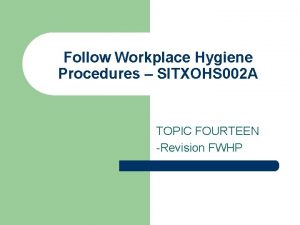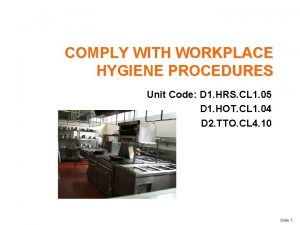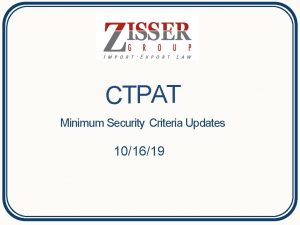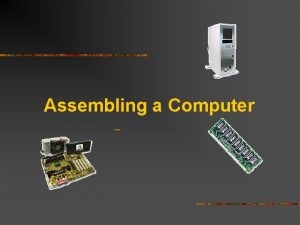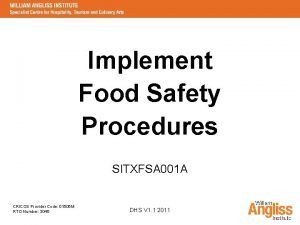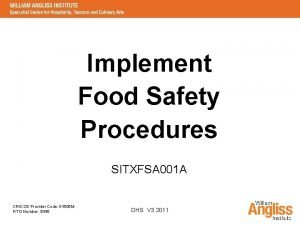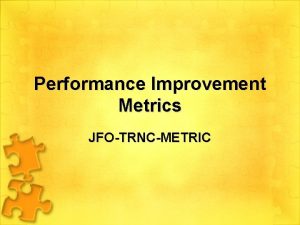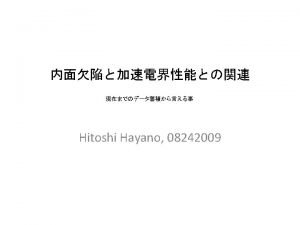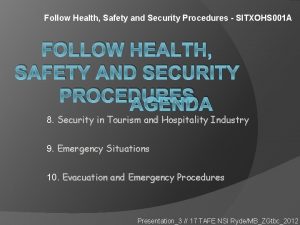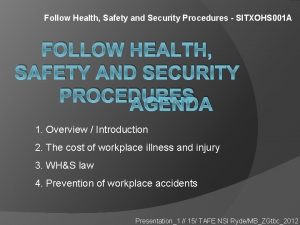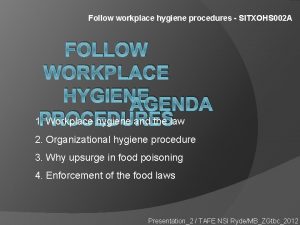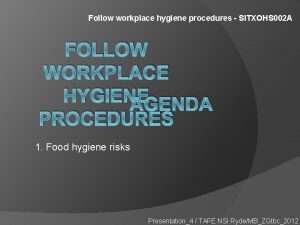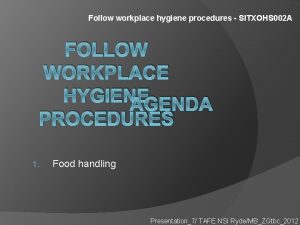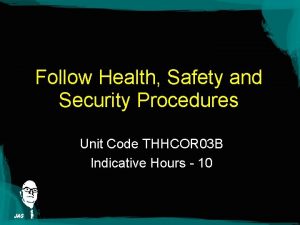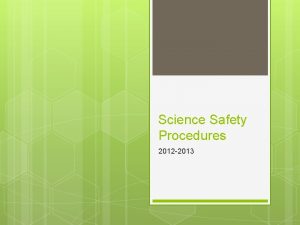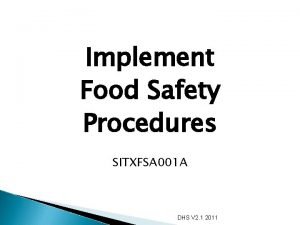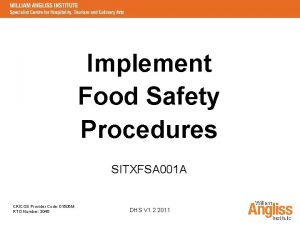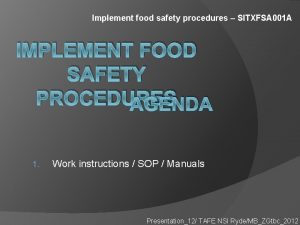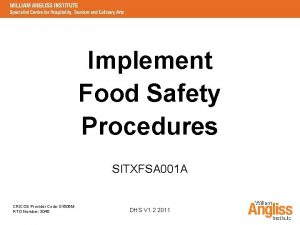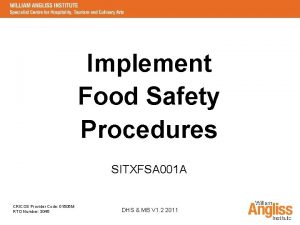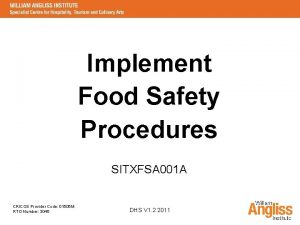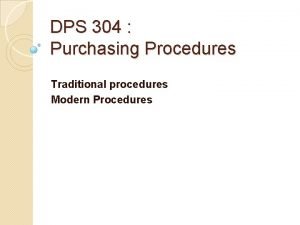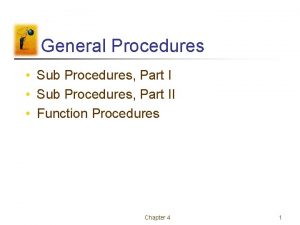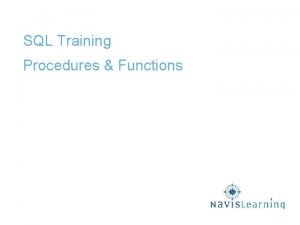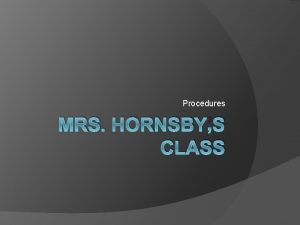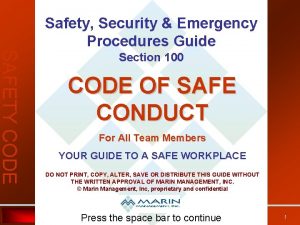Follow Health Safety and Security Procedures SITXOHS 001




























- Slides: 28

Follow Health, Safety and Security Procedures - SITXOHS 001 A FOLLOW HEALTH, SAFETY AND SECURITY PROCEDURES AGENDA 5. Common Hazards in the workplace 6. WH&S…. . ; types of Accidents and unsafe hazardous working conditions 7. Safe Personal Presentation Standards Presentation_2 // 16/ TAFE NSI Ryde/MB_ZGtbc_2012

REVISION � 1. What is a hazard Anything that has the potential to cause harm � 2. Define “Duty of Care” Duty of Care means planning for the prevention of workplace accidents, injuries and illness and putting in place a return to work program for injured workers.

TOPIC 5 Common Hazards in the workplace 1. Physical 2. Chemical 3. Ergonomic 4. Biological 5. Radiation 6. Psychological

Workplace Hazards can be grouped under the following 6 categories Physical Chemical Ergonomic HAZARDS Radiation Psychological Biological The first step in hazard or accident prevention is to identify what constitutes a potential workplace hazard. Particular items or elements that can be regarded as hazards are covered under the above 6 categories 4

Physical Hazard � Noise � Vibration � Lighting � Electrical � Heat/cold � Fire � Machine guards � Working space (too crowded/cramped) 5

Chemical Hazard � Gases � Dusts � Fumes � Vapors � Liquids 6

Ergonomic Hazard � Tool design � Equipment design – knives and equipment � Job/task design � Workstation design � Manual handling (lifting and carrying) 7

Psychological Hazard � Shiftwork � Workload � Dealing with public � Harassment � Discrimination � Threat of danger � Low level constant noise 8

Biological Hazard � Infections � Bacteria � Virus 9

Radiation Hazard � Microwaves � Infra red � Ultra voilet � Lasers � X-rays 10

General Hazards There are numerous other hazards that exist and all employees must take an active role in identifying and eliminating them. Be alert and report any hazard relating to: � � � � poor storage torn carpet fire hazards safety signs obstructions sharp edges, slippery floors and spillages poor lighting � � � equipment, utensils, and safety guards Faulty or damaged equipment Appropriate protective clothing Electrical appliances faulty or have frayed cords Poor maintenance HAZARDS EXIST EVERYWHERE; THE ACTION YOU TAKE NOW MAY PREVENT YOUR OWN INJURY 11

TOPIC 6 WH&S…. . ; types of Accidents and unsafe hazardous working conditions 1. Tourism 2. Front of House 3. Cookery / Kitchen 12

Common or Typical Workplace Accidents are: Cuts and abrasions: � mostly from kitchen knives � broken glass � can lids � sharp edges of equipment Falls: � slipping on spillages � bumping into other people � tripping over items 13

Common or Typical Workplace Accidents are: Burns and Scalds � Strains and Sprains steam � lifting incorrectly slips and falls � gas flames � boiling water � � hot oils � � hot pans � flaming liquids RSI (Office) (Repetitive Strain Injury) 14

Common or Typical Workplace Accidents are: Machine Injuries � clothing caught by machinery � fingers/toes caught in machinery � electrical shock Chemical Injuries � ingestion (swallow) of poisonous chemicals � spillage of corrosive chemicals on persons � chemical reactions 15

TOPIC 7 Safe Personal Presentation Standards 1. Image / Presentation 2. Professionalism 3. Safety & Health issues 16

17

Personal presentation standards � The first impression people have of us is very important. Both customers and colleagues demand a high standard of personal presentation and behaviour. When people look at us, they immediately begin to form an opinion about us. � STANDARDS refer to the minimum required way “we look and present ourselves”. There are minimum industry standards that apply with regard to personal presentation. 18

Personal presentation standards Industry standards Standards expected across the entire industry, irrespective of the sector. They will apply, for instance, in health, hygiene and safety issues Enterprise standards – Standards set by the individual enterprise that determine, for e. g. the quality of service offered and employee personal presentation 19

Management’s responsibility for personal presentation including Hygiene, Personal Grooming and PPCE � Ensure premises conform to all relevant (design) legislation � Maintain adequate and appropriate food storage areas � Install separate hand washing and food cleaning basins � Observe and enforce hygienic food handling practices 20

Management’s responsibility for good hygiene � Maintain appropriate cleaning and sanitising procedures � Train employees in personal hygiene and correct food handling � Install employee wash rooms 21

Employees responsibility for good hygiene � Maintain high standard of personal hygiene � Follow food handling procedures/practices � Understand the nature of foods and their susceptibility to bacteria growth � Report food hygiene breaches 22

Employees responsibility for good hygiene � Report communicable diseases (don’t work when carrying or infected) � Observe correct cleaning and sanitising � Wear and use appropriate PPC&E � Follow procedures for handling blood spills, the disposal of sharps and dirty linen � Cover skin lesions 23

PPC&E is designed to protect us from hazards that may cause injury and illness. If a particular piece of PPC&E is not available in the workplace, we can ask our employer to get is for us. In the workplace, PPC&E includes: our uniform, including appropriate shoes � disposable and chemical-resistant gloves � face masks � hairnets � aprons � glasses/goggles � tongs � Trolleys � 24

Accident Prevention Summary � Use of clothing, footwear and equipment as appropriate to the particular workplace environment � Correct storage of goods and chemicals � Correct maintenance and use of guards on machinery � Correct sitting lifting and handling techniques � Follow WH&S Procedures , manual handling and SOP’s 25

Developing WHS policies and procedures � Policies and procedures are developed to help employers and employees meet their obligations under WHS requirements. 26

What is a policy? � The position, an organisation takes on an issue � It can also be a standard, rule or regulation. � An organisations policy usually forms part of its overall goals to achieve OHS in the workplace. 27

What is a procedure? �A procedure is how to carry out a task or duty. Usually a step by step guide that helps ensure compliance and consistency is the way a task is completed. 28
 I will follow you wherever you blank
I will follow you wherever you blank Follow workplace hygiene procedures
Follow workplace hygiene procedures Compliance with workplace hygiene procedures
Compliance with workplace hygiene procedures Provate security
Provate security Agricultural security ctpat
Agricultural security ctpat Chapter 10 workplace safety procedures
Chapter 10 workplace safety procedures Motherboard jumper settings diagram
Motherboard jumper settings diagram Implement food safety procedures
Implement food safety procedures Implement food safety procedures
Implement food safety procedures Health professionals follow-up study
Health professionals follow-up study Mehmet nacar 001
Mehmet nacar 001 When to reject null hypothesis critical value
When to reject null hypothesis critical value 20 ppm i decimalform
20 ppm i decimalform Acad 02-001
Acad 02-001 Ms09-001 metasploit
Ms09-001 metasploit Nom 001 stps 2008 edificios locales e instalaciones
Nom 001 stps 2008 edificios locales e instalaciones Numero decimal
Numero decimal 99366 cpt code
99366 cpt code W trzech koszykach jest razem 72 jabłek
W trzech koszykach jest razem 72 jabłek Pyp-001
Pyp-001 60m height
60m height 100 011
100 011 Tms320dm
Tms320dm Sol001
Sol001 Semt.001
Semt.001 Write 702 001 in expanded form
Write 702 001 in expanded form Nfp 01012
Nfp 01012 Easa cm-swceh-001
Easa cm-swceh-001 In mudra loan rs.50 001 to rs.500 000 are categorised as
In mudra loan rs.50 001 to rs.500 000 are categorised as

